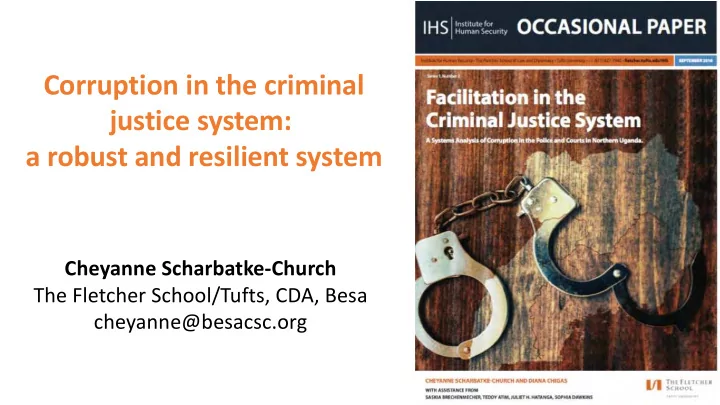

Corruption in the criminal justice system: a robust and resilient system Cheyanne Scharbatke-Church The Fletcher School/Tufts, CDA, Besa cheyanne@besacsc.org
Our purpose develop an analytic process to understand the system of corruption in fragile states that generates more effective anti-corruption programming in the CJS in contexts of fragility
AGENDA Corruption in the criminal justice system • The Problem • Why corruption in justice matters • Systems-based corruption analysis methodology • Effective Program • What’s Next
`
Classic Principal-Agent “formula” C = M + D - A Klitgaard Equation
Conflict Life Cycle Anti-corruption Mythical time in the future
Locks societies into negative peace Negative peace is the Positive peace is the Systemic Corruption absence of violence . absence of structural violence; justice for all. • Torture & abuse • Disempowers • Exacerbates inequality • Distrust in state
What have we done? 2014 in DRC: interviews (150) Literature New Research: Review Approach 3 cases 2017 Complex Central PEA, collective 2016 Adaptive Africa Uganda: action, System Republic: interviews negotiation, interviews (111) evals etc. (120)
Corruption System in the CJS: Northern Uganda
How the approach has been useful (so far) 1. Improves understanding of the problem 2. Identification of atypical points of intervention 3. Enables testing the plausibility of theories of change 4. Generate strategic program co-ordination
Yellow stars: programming areas Red Stars: No programming
Where to next? Social Norms & Corruption
Social Norms What they are: What they are not: • What: Unwritten rule that • not the behavior pattern guides behavior of an • not the same as individual individual attitudes • Where: Norms emerge • not the same as through social interaction morals/values within a group • Why: Sanctions for non- compliance (internal & external)
Why (we think) social norms matter • Acceptability of corruption (no shame) • We believe: social norms are drivers that contribute to resiliency • Possible high leverage to change the system • Acts as a brake to sustainable behavior change
Fo or r di ig gn ni it ty y a an nd d th he e ri ig gh ht ts s of f w wo om me en n & & g gi ir rl ls s 1. Engage sooner not later 2. Seek to understand drivers 3. Adopt a systems lens of analysis
Thank you! Further information is available at: Subscribe: Corruption in Fragile States Blog Series Email: Cheyanne@besacsc.org
Leverage Points in the System
Vicious Cycle
Recommend
More recommend